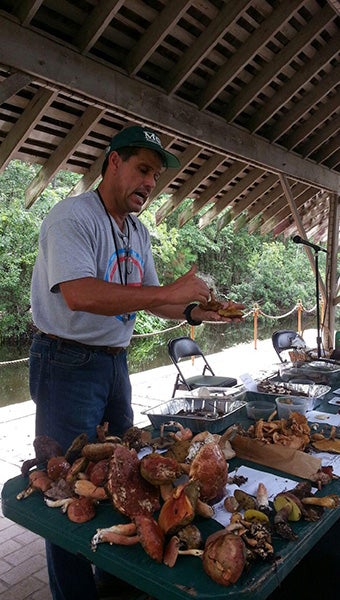Arboretum Paths: It’s time for our mushroom walk!
Published 7:00 am Wednesday, August 26, 2015

Dr. Juan Mata identifies specimens collected on a past Arboretum mushroom walk .
Photo by Pat Drackett
It’s time again for the Crosby Arboretum’s annual mushroom walk, to be led by biology professor Dr. Juan Mata from the University of South Alabama. If you’ve never participated in such an event, you’ll be in for a treat. We are looking forward to a day that will bring us an abundant variety and much to discuss.
I’ve been keeping my eye on the weather, hoping that the moisture from recent rains will stick around until Saturday, and that we’ll find fungi popping up all over the grounds that morning.
So far, so good, as staff has reported seeing mushrooms throughout the property.
Some mushroom species are common at the arboretum, while others may be much more rarely seen. One of my favorite unusual species is called a cauliflower mushroom (Sparassis crispa) found growing near the decaying roots of the mature loblolly pine on the Pond Journey. The form of this fungi resembles a cross between a sea coral and a human brain, as it has striking undulating folds.
We have at times encountered chanterelle mushrooms, a delightful find for mushroom collectors who like to cook with these fungi. Of course, this brings up the opportunity to present the warning that you must never consume mushrooms without being 100% certain of their identification.
While field guides can set you on the path for learning, it is advisable to seek out experts in the field to confirm your finds. Regional groups such as the Gulf States Mycological Society (www.gsmyco.org) offer excellent opportunities to learn more about the culinary aspects of mushroom hunting through regular field walks.
Even in the cold of winter, mushrooms continue to develop and put on a show. Amanita mushrooms often appear along the edges of our pathways and service drive. These are a strikingly beautiful group of mushrooms, but are some of the most toxic species in the world. While the scarlet Amanita muscaria (Fly Agaric) is not deadly, ingestion will result in symptoms that resemble alcohol poisoning, and can cause delirium and coma.
The orange eastern form of Fly Agaric is common in the woodland and savanna exhibits at the Arboretum. The caps are brilliant shades of orange dotted with whitish warty spots. Although there are a few edible species of Amanita in North America, they do closely resemble the poisonous species.
If you plan on coming out on Saturday, Dr. Mata recommends bringing a knife and a collecting basket or bag (we will provide paper bags and plastic knives). You may also bring a towel or wax paper to place between the mushrooms. Participants are welcome to bring fungi they have collected elsewhere for identification.
The program will begin at 10 a.m. with an introduction to “the fascinating world of fungi” on the Pinecote Pavilion. After the introduction, we will spread out on the grounds to collect specimens and return around 11 a.m. to display them on tables to have Dr. Mata make identifications and identify and describe them to the audience. This experience is a delightful way to learn more about the world of nature around us.
When people think of fungi, mushrooms usually come to mind, but these are only a small fraction of the fungal diversity found in our coastal woodlands. A mushroom is only the above ground fruiting bodies of a fungus, and the vegetative body is an underground network of tubular filaments called a mycelium. Fungal mats are the largest biological entities on the planet, with some individuals covering more than 20,000 acres.
On past field walks, Dr. Mata has pointed out that fungi are more closely related to plants than animals. Fungi are important to humans because of their relationship to producing our food – for example, bread, cheese, and wine. They also have a critical ecological importance through the partnerships that they form with other plants. Some fungi decompose organic material, such as the lignin in wood.
Another enticement for coming to the Arboretum this weekend is the recent appearance of the scarlet pine lilies (Lilium catesbaei) in the Savanna Exhibit. Also called Catesby’s lily, these ephemeral perennials are found in wet pine savannas and bogs of the coastal plain. Come experience these beautiful native wildflowers first-hand.
The mushroom program will begin at 10 a.m. and will be over around noon. Admission is free to members and $5 for non-members ($2 for children under 12). Call the office at 601-799-2311 to sign up.
The Arboretum is open Wednesdays through Sundays from 9 a.m. to 5 p.m. and located in Picayune, off I-59 Exit 4, at 370 Ridge Road (south of Walmart and adjacent to I-59). For more information about our programs and events, see the website at www.crosbyarboretum.msstate.edu.
FOR FURTHER EXPLORATION: Research the mushroom species mentioned above at your local library or on the Internet, and learn to recognize them in the field.
By Patricia Drackett





